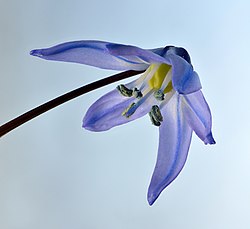From Wikipedia
Open on Wikipedia
| Siberian squill | |
|---|---|

| |
| Scientific classification | |
| Kingdom: | Plantae |
| Clade: | Tracheophytes |
| Clade: | Angiosperms |
| Clade: | Monocots |
| Order: | Asparagales |
| Family: | Asparagaceae |
| Subfamily: | Scilloideae |
| Genus: | Scilla |
| Species: | S. siberica
|
| Binomial name | |
| Scilla siberica | |
Scilla siberica, the Siberian squill or wood squill, is a species of flowering plant in the family Asparagaceae, native to southwestern Russia, the Caucasus, and Turkey. Despite its name, it is not native to Siberia.
Many parts of the plant are poisonous to eat for some animals.[3][4]
Description
[edit]
Growing to 10–20 cm (4–8 in) tall by 5 cm (2 in) wide, it is a bulbous perennial, with two to four strap-shaped leaves appearing in early spring, at the same time as the nodding, blue, bell-shaped flowers.[5]
The flowers have six tepals and six stamens, and are arranged singly or in racemes of two or three. Petals may be reflexed to the horizontal when sunlight is bright, but are more often cup-shaped. The flowers are usually blue, but those of Scilla siberica var. alba are white. The stamens of Scilla are separate, unlike those of the related genus Puschkinia, which are fused into a tube. The pollen is dark blue.
After flowering, the flower stems become limp as capsules (pods) mature. At maturity, the capsules become purple and split open, releasing small, dark brown seeds. When the seeds are mature, the leaves wither and the plant goes dormant until the next spring.
The seedlings are hollow-leaved.
Cultivation
[edit]S. siberica is cultivated for its bluebell-like flowers. It naturalizes rapidly from seed. At 15 cm (5.9 in), it is suitable for planting in grass, and will spread by seed to form large colonies that go dormant by the time grass needs to be mowed. In the Midwestern United States it is becoming invasive in some situations.[6]
This plant has gained the Royal Horticultural Society's Award of Garden Merit.[7][8]
Gallery
[edit]-
Seed capsules
-
Bulbs
-
Klepacza Park in Łodz, Poland
-
Pendulous flowers at various stages of development
-
In Calgary, Alberta in April
-
Pollen grains under a microscope with different illumination methods (EPI illumination, bright field, differential interference contrast, phase contrast, autofluorescence)
See also
[edit]References
[edit]- ^ "Scilla siberica Andrews". Plants of the World Online. The Trustees of the Royal Botanic Gardens, Kew. n.d. Retrieved October 14, 2022.
- ^ "Scilla siberica Andrews". Catalogue of Life. Species 2000: Leiden, the Netherlands. Retrieved October 14, 2022.
- ^ "Scilla siberica".
- ^ "Siberian Squill: Blue Harbingers of Spring". Iowa State University.
- ^ RHS A-Z encyclopedia of garden plants. United Kingdom: Dorling Kindersley. 2008. p. 1136. ISBN 978-1405332965.
- ^ Chayka, Katy; Dziuk, Peter (2016). "Scilla siberica (Siberian Squill)". Minnesota Wildflowers.
- ^ "RHS Plant Selector - Scilla siberica". Retrieved 5 March 2021.
- ^ "AGM Plants - Ornamental" (PDF). Royal Horticultural Society. July 2017. p. 96. Retrieved 6 November 2018.
External links
[edit]- Shulkina, Tatyana. "Scilla siberica". Ornamental Plants from Russia and Adjacent States of the Former Soviet Union – via eFloras.org, Missouri Botanical Garden, St. Louis, MO & Harvard University Herbaria, Cambridge, MA.
- Pacific Bulb Society
- The Plant Expert
- "Plants Profile for Scilla siberica (Siberian squill)". Natural Resources Conservation Service.





